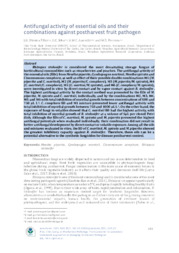Antifungal activity of essential oils and their combinations against postharvest fruit pathogen.
Antifungal activity of essential oils and their combinations against postharvest fruit pathogen.
Author(s): OLIVEIRA FILHO, J. G.; SILVA, G. C.; AZEREDO, H. M. C. de; FERREIRA, M. D.
Summary: ABSTRACT: Rhizopus stolonifer is considered the most devastating storage fungus of horticultural commodities such as strawberries and peaches. The antifungal activity of the essential oils (EOs) from Mentha piperita, Cymbopogon martinii, Mentha spicata and Cinnamomum camphora, as well as effect of their possible double combinations M1 (M. piperita and C. martinii), M2 (M. piperita/C. camphora), M3 (M. piperita/M. spicata), M4 (C. martinii/C. camphora), M5 (C. martini/M. spicata), and M6 (C. camphora/M. spicata), were investigated in vitro by direct contact and by vapor contact against R. stolonifer. The highest antifungal activity by the contact method was promoted by the EOs of M. piperita, M. spicata and C. martinii, individually, and by the combinations M2, M3, M4, M5 and M6 with total inhibition of mycelial growth between concentrations of 500 and 750 μL L-1. C. camphora EO and M1 mixture presented lower antifungal activity with total inhibition of mycelial growth between 750 and 1000 μL L-1. On the other hand, the exposure of fungi to volatiles showed that C. martinii EO had the highest activity, with total inhibition of mycelial growth of R. stolonifer at a volume of 5μL per closed Petri dish. Although the EOs of C. martinii, M. spicata and M. piperita presented the highest antifungal potentials when evaluated individually, their combination did not result in better antifungal development by direct contact or volatile exposure. Among all the oils and mixtures evaluated in vitro, the EO of C. martinii, M. spicata and M. piperita showed the greatest inhibitory capacity against R. stolonifer. Therefore, these oils can be a potential alternative to the synthetic fungicides for disease postharvest control.
Publication year: 2021
Types of publication: Journal article
Observation
Some of Embrapa's publications are published as ePub files. To read them, use or download one of the following free software options to your computer or mobile device. Android: Google Play Books; IOS: iBooks; Windows and Linux: Calibre.
Access other publications
Access the Agricultural Research Database (BDPA) to consult Embrapa's full library collection and records.
Visit Embrapa Bookstore to purchase books and other publications sold by Embrapa.

